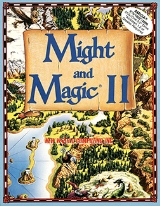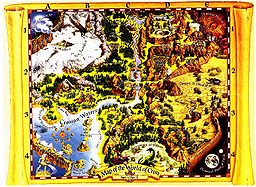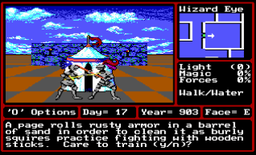
Might and Magic II: Gates To Another World
Encyclopedia
Might and Magic II: Gates to Another World is a computer role-playing game. It is the sequel to the game Might and Magic: The Secret of the Inner Sanctum.
While in many ways Might and Magic 2 is an updated version of the original, the improved graphics help greatly with navigation, and the interface added several functions that facilitated gameplay, such as a "delay" selector which allowed for faster or slower response times, and a spinning cursor when input was required - all features lacking in Might and Magic 1.
Other new features include two new character class
es, an increased number of spells, the introduction of class "upgrade" quests and more than twice the number of mini-quests. Also added was "secondary skills" such as mountaineering (necessary for travelling mountainous regions) and linguist (raising the character's intelligence, and necessary for reading certain messages). Each character could have up to two secondary skills. The game introduced an automap feature to the series, activated by training a character in the cartographer skill.
 Perhaps the most peculiar development in this game was the numeric scope. Character levels could reach 255 ((28)-1), at which point they could train without limit, provided they had enough gold. Hit points could be extended as high as 65535 ((216)-1) and magic points up to 9999. To nearly any item, a "+" bonus could be added via an enchantment. This "+" bonus increased the weapon's damage or attribute bonus, as in Dungeons & Dragons
Perhaps the most peculiar development in this game was the numeric scope. Character levels could reach 255 ((28)-1), at which point they could train without limit, provided they had enough gold. Hit points could be extended as high as 65535 ((216)-1) and magic points up to 9999. To nearly any item, a "+" bonus could be added via an enchantment. This "+" bonus increased the weapon's damage or attribute bonus, as in Dungeons & Dragons
, but unlike D&D the ceiling on "+" bonuses was 63.
Might and Magic 2 pitted the player's party against any one of 255 monsters varying from 5 hit points to 64000. Battles could consist of up to 255 opponents.
While Might and Magic 2 remained a battle-focused game, there were many puzzles to be solved, and curiosities to be discovered. There is a cave with a sex-change device, for instance, and scattered about the land are seemingly nonsensical colored messages that eventually combines into useful hints (as in the first game). Most of the quests in the game require the player to solve puzzles rather than look for the next hack and slash battle.
Time travel
was added, though its ramifications were practically nil with the exception of being necessary to fight the final boss. The taverns feature humorous culinary selections and there are various absurdities strewn about, such as the ability to get drunk off of too much ale, which would result in reduced abilities of the character. Stats can be increased at the annual circus, which requires a collection of cupie dolls
to play the games.
 A character can belong to one of eight classes. Each class has at least one prime statistic
A character can belong to one of eight classes. Each class has at least one prime statistic
which a character must equal or exceed to be a member of that class. All classes other than Knights or Barbarians also have special skills or abilities.
All six classes featured in Might and Magic Book One: Secret of the Inner Sanctum are available in the sequel: Knight, Paladin, Archer, Cleric, Sorcerer and Robber. In addition two new classes are introduced:
Ninja
Ninja are specialized Robbers, having thieving abilities to a lesser degree, plus the ability to assassinate their opponents.
Barbarian
Barbarians have high hit points and reasonable fighting abilities, though a limited selection of weapons and armour.
#146 by Hartley, Patricia, and Kirk Lesser in "The Role of Computers" column. The reviewers gave the game 4 out of 5 stars. Computer Gaming World
gave the game a mixed review, noting several bugs in the 1.0 version. The review also lamented the simple plotline, saying, "Might & Magic II seems to have swerved off the path in the boring "monster mash/Monty Haul
" direction, where ever-more-powerful characters with ever-more-powerful weapons fight ever-more-powerful monsters until it all escalates into the realm of the ludicrous."
Background
After the events of Might and Magic 1, the adventurers who helped Corak defeat Sheltem on VARN take the "Gates to Another World" located in VARN to the land of CRON (Central Research Observational Nacelle). The land of CRON is facing many problems brought on by the encroachment of Sheltem and the adventurers must travel through CRON, the four elemental planes and even through time to help Corak stop Sheltem from flinging CRON into its sun.While in many ways Might and Magic 2 is an updated version of the original, the improved graphics help greatly with navigation, and the interface added several functions that facilitated gameplay, such as a "delay" selector which allowed for faster or slower response times, and a spinning cursor when input was required - all features lacking in Might and Magic 1.
Gameplay
As with Might and Magic 1, the player used up to six player-generated characters at a time, and a total of twenty-six characters could be created, who thereafter stayed at the various inns across CRON. To continue game continuity it was possible to "import" the characters developed from the first game. Additionally, Might and Magic 2 became the first game in the series to utilize "hirelings", predefined characters which could extend the party to eight active characters. Hirelings were controlled like regular characters but required payment each day; pay increased with level.Other new features include two new character class
Character class
In role-playing games, a common method of arbitrating the capabilities of different game characters is to assign each one to a character class. A character class aggregates several abilities and aptitudes, and may also sometimes detail aspects of background and social standing or impose behaviour...
es, an increased number of spells, the introduction of class "upgrade" quests and more than twice the number of mini-quests. Also added was "secondary skills" such as mountaineering (necessary for travelling mountainous regions) and linguist (raising the character's intelligence, and necessary for reading certain messages). Each character could have up to two secondary skills. The game introduced an automap feature to the series, activated by training a character in the cartographer skill.

Dungeons & Dragons
Dungeons & Dragons is a fantasy role-playing game originally designed by Gary Gygax and Dave Arneson, and first published in 1974 by Tactical Studies Rules, Inc. . The game has been published by Wizards of the Coast since 1997...
, but unlike D&D the ceiling on "+" bonuses was 63.
Might and Magic 2 pitted the player's party against any one of 255 monsters varying from 5 hit points to 64000. Battles could consist of up to 255 opponents.
While Might and Magic 2 remained a battle-focused game, there were many puzzles to be solved, and curiosities to be discovered. There is a cave with a sex-change device, for instance, and scattered about the land are seemingly nonsensical colored messages that eventually combines into useful hints (as in the first game). Most of the quests in the game require the player to solve puzzles rather than look for the next hack and slash battle.
Time travel
Time travel
Time travel is the concept of moving between different points in time in a manner analogous to moving between different points in space. Time travel could hypothetically involve moving backward in time to a moment earlier than the starting point, or forward to the future of that point without the...
was added, though its ramifications were practically nil with the exception of being necessary to fight the final boss. The taverns feature humorous culinary selections and there are various absurdities strewn about, such as the ability to get drunk off of too much ale, which would result in reduced abilities of the character. Stats can be increased at the annual circus, which requires a collection of cupie dolls
Kewpie doll (toy)
Kewpie dolls and figurines are based on comical strip-like illustrations by Rose O'Neill that appeared in Ladies' Home Journal in 1909. The small dolls were extremely popular in the early 1900s. They were first produced in Ohrdruf, a small town in Germany, then famous for its toy-manufacturers....
to play the games.
Non-standard aspects of the game
There are many aspects of this game which were not standard for RPGs of the time, such as:- Characters aging during gameplay, and when reaching old age (~75) they would die randomly due to natural causes. The spell that reverses this process usually fails, resulting in increasing the character's age as opposed to decreasing it. However, paying a visit to a health spa on a resort isle can reduce the character's age.
- The ability to travel into the past, specifically nine different centuries, although only two of them seemed relevant to the main story and two to a sidequest.
- Class-specific quests and class-restricted areas, forcing the player to split up the party, or use different combinations of characters.
- In a departure from the high fantasyHigh fantasyHigh fantasy or epic fantasy is a subgenre of fantasy that is set in invented or parallel worlds. High fantasy was brought to fruition through the work of authors such as J. R. R. Tolkien and C. S. Lewis, whose major fantasy works were published in the 1950s...
flavour typical for RPGs, the last dungeon requires the PCsPlayer characterA player character or playable character is a character in a video game or role playing game who is controlled or controllable by a player, and is typically a protagonist of the story told in the course of the game. A player character is a persona of the player who controls it. Player characters...
to board a spaceship and solve an encrypted messageCryptogramA cryptogram is a type of puzzle which consists of a short piece of encrypted text. Generally the cipher used to encrypt the text is simple enough that cryptogram can be solved by hand. Frequently used are substitution ciphers where each letter is replaced by a different letter or number. To solve...
with a time limit in order to escape the planet.
Character classes

Statistic (role-playing games)
A statistic in role-playing games is a piece of data which represents a particular aspect of a fictional character. That piece of data is usually a integer or, in some cases, a set of dice....
which a character must equal or exceed to be a member of that class. All classes other than Knights or Barbarians also have special skills or abilities.
All six classes featured in Might and Magic Book One: Secret of the Inner Sanctum are available in the sequel: Knight, Paladin, Archer, Cleric, Sorcerer and Robber. In addition two new classes are introduced:
Ninja
Ninja are specialized Robbers, having thieving abilities to a lesser degree, plus the ability to assassinate their opponents.
Barbarian
Barbarians have high hit points and reasonable fighting abilities, though a limited selection of weapons and armour.
Reception
The game was reviewed in 1989 in DragonDragon (magazine)
Dragon is one of the two official magazines for source material for the Dungeons & Dragons role-playing game and associated products, the other being Dungeon. TSR, Inc. originally launched the monthly printed magazine in 1976 to succeed the company's earlier publication, The Strategic Review. The...
#146 by Hartley, Patricia, and Kirk Lesser in "The Role of Computers" column. The reviewers gave the game 4 out of 5 stars. Computer Gaming World
Computer Gaming World
Computer Gaming World was a computer game magazine founded in 1981 by Russell Sipe as a bimonthly publication. Early issues were typically 40-50 pages in length, written in a newsletter style, including submissions by game designers such as Joel Billings , Dan Bunten , and Chris Crawford...
gave the game a mixed review, noting several bugs in the 1.0 version. The review also lamented the simple plotline, saying, "Might & Magic II seems to have swerved off the path in the boring "monster mash/Monty Haul
Dungeon crawl
A dungeon crawl is a type of scenario in fantasy role-playing games in which heroes navigate a labyrinthine environment, battling various monsters, and looting any treasure they may find...
" direction, where ever-more-powerful characters with ever-more-powerful weapons fight ever-more-powerful monsters until it all escalates into the realm of the ludicrous."

